Gills Harbour Ltd's Chair Welcomes MPs Conclusions
18th March 2012
The Chairman of the community body that owns and operates Gills Harbour, on the shores of the Pentland Firth's Inner Sound, is welcoming the findings of a group of Parliamentarians whose Inquiry report 'The Future of Marine Renewables in the UK' has just been published.
The Westminster MPs of the Energy & Climate Change Committee looked at the future for electricity that can be generated by harnessing the 'kinetic energy' in flow of Britain's tidal streams and from the power of the waves; both technologies are experimenting with turbines that are still at the 'prototype' stage.
The harbour, which belongs to the 550 electors of Canisbay Parish's North Coast, from West Mey to John O'Groats (inclusive), lies only one mile and four miles respectively from the only two seabed sites off Caithness which have been leased by the Crown Estate for generating tidal stream electricity.
The community's trading company is known as Gills Harbour Ltd (GHL) and is chaired by former Councillor Bill Mowat, of John O'Groats.
It aims to 'manage, operate maintain, improve and develop' the busy little port 'for the encouragement of employment through trade, commerce, industry, transport, energy and marine activities' at or in the vicinity of the harbour for the benefit of local folk and 'the wider North of Scotland communities.
The Energy & Climate Change group's report is the first of two House of Commons 'Select Committees' to look in aspects of future tidal stream energy: The Scottish Affairs Select Committee launches its Inquiry report into the Crown Estate in Scotland at the Kingsmills Hotel in Inverness next Monday (19.03.12).
Both groups visited Orkney, but the Scottish Affairs Committee, which has three MP members with close Caithness connections, travelled across the Pentland Firth last summer on the modern catamaran ferry Pentalina to Gills Harbour last summer as guests of the community company, while Pentland Ferries managing director Andrew Banks and harbour office-bearers pointed out the locations of the seabed sites.
The Energy Committee, chaired by Conservative MP Tim Yeo, states that marine renewables, that it defines as wave and tidal-stream, have the potential to supply 20% of Britain's current electricity needs from 20210 onwards.
It states: 'The priority over the next decade must be to focus on reducing the costs of marine renewables'.
The MPs urge the UK Government's Department of Energy and Climate Change to set specific cost-reduction targets so that progress can be tracked.
But it states the Britain is currently a world-leader in the field and it wants the UK to 'follow the example of Denmark in the 1980s in establishing a domestic wind-power wind-power industry'.
It argues that marine renewables 'could provide new jobs and industries, while the UK could also gain by exporting goods and skills as other markets begin to emerge around the world'.
Amongst those providing evidence to the Committee was Mr Dan Pearson, the managing director of MeyGen Ltd, which holds the seabed lease for the Inner Sound, the narrow 1.5 miles wide channel between Canisbay and Stroma Island. Mr Pearson has become a well-known 'face' locally as the company's scheme progresses for a 400MW subsea power station.
MeyGen Ltd aims to take the generated power ashore by underwater cables and feed it into three large rectifier/transformer buildings on the Inner Sound's coast; from there will go by underground cable to a planned large electricity sub-station planned by Scottish Hydro-Electric Transmission Ltd for near Philip's Mains farm in Mey, before it is sent by two separate wooden-poles lines to link with the upgraded Dounreay to Beauly (near Inverness) National Grid pylons line.
Yesterday Mr Mowat said: 'The MPs are absolutely correct to focus on cost reduction as being a key element in developing a successful industry, both locally and nationally.
'We believe that we at Gills Harbour will be able to help there by providing a base for short-distance sea transport, which cuts out the need for long carbon-consuming sea-miles, especially for vessels in the 25 metre and under class'.
The Pentland Firth stretches 16 miles Eastward from Dunnet Head to the Pentland Skerries and commercial interest is focussed on its narrower eastern end, where the constricted tide-streams flow most swiftly. Gills Bay is the most sheltered inlet on the Caithness side of the Firth and the harbour lies at its inland apex.
Mr Mowat added: 'The other key issue to be faced is marine safety. Gills Harbour lies in between the two 'tide-races' emanating on the Caithness side of the Firth; the Merry Men of Mey and the Bore of Duncansby.
Those are the two best-known sea hazards of the sea-area where white-water waves break every day of the year on the appropriate tide.
'Neither needs to be transited by vessels sailing out of Gills to any of the four leased seabed tidal-stream sites, two of which are in Orkney waters, the other being Scottish Power Renewables Ness of Duncansby lease, four miles east of Gills.
At the Merry Men of Mey multi-directional swells can rear up as high as 12 metres ( the equivalent of a collapsing 4-storey building) when the streams are opposed by prevailing Westerly gales and distantly-generated Atlantic waves in winter conditions.
Next Tuesday evening (20.03.12 at 19:30) Gills Harbour Ltd is holding its AGM at the new Pentland Ferries terminal building at Gills Harbour, to be followed by a regular members meeting.
Mr Mowat added: 'Because of the potential importance of tidal stream electricity developments to Canisbay, we urge as many local persons as possible to attend. We aim to facilitate around 50 new sustainable jobs in this area, which will have a substantial positive effect on the economy of Canisbay and beyond and do our bit to help to ameliorate the effects of the Dounreay run-down.'.
2012/13 annual membership cards are available from secretary/treasurer John Green, also of John O'Groats, at �10:00 each.
Related Businesses
Related Articles
Three Cats At Gills Harbour
Two catamaran work-boats berthed at Gills Harbour this week with the trans-Pentlnd ferry MV Alfred, also a catamaran, in the background. The larger workboat is MPC Athenia which was being used as a floating base or ROVs - remote underwater vessels, for detailed inspections on the three turbines operating at the MeyGen demonstration subsea site one and a half miles off Gills Harbour.
GILLS HARBOUR Ltd ANNUAL GENERAL MEETING
GILLS HARBOUR Ltd - ANNUAL GENERAL MEETING at JOHN O'GROATS VILLAGE HALL, MONDAY JUNE 13th @ 7.30 PM. GILLS HARBOUR IS THE ONLY OFFICIALLY-RECOGNISED 'ECONOMIC DEVELOPMENT AREA' IN NE CAITHNESS.Latest Boats At Gills Harbour For Work At Meygen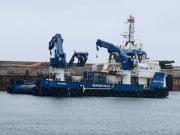
£10 million 'Isle of Jura' temporarily based at Gills Harbour in Far North of Scotland for her crew's debut tasks in the tidal-stream electricity field at the MeyGen sub-sea site, one mile off the little Caithness's port entrance channel. One of the UK's most modern marine renewables service vessels made her debut calls at community-owned Gills Harbour, near John O'Groats, over the 2021 Spring Equinoctial weekend.
Busy Gills Harbour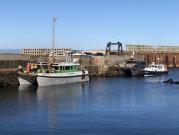
Its been a busy few days at local community-owned Gills Harbour ..... sometimes in suberb sunny weather as here ...
Energy Developments Continue at Gills Harbour and the Pentland Firth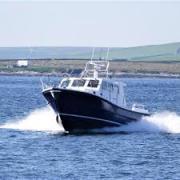
The company behind the world-leading tidal-stream prototype power plant in the Pentland Firth's Inner Sound is set to start manufacturing a new-style turbine that is hopes will reduce the project's generating costs. Simec Atlantis Energy (SAE) and a privately-owned specialist engineering firm from Spain's Bay of Biscay coastline have jointly been conducting 'research and development' (R& D) on the project for almost a year and are now ready to give it the go-ahead.
New Generation of office-bearers set to step up at Gills Harbour Ltd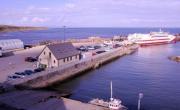
A new generation of younger local folk look set to take over the reins of running Gills Harbour Ltd, the local company that owns and operates the busy little port on the shores of the Pentland Firth's Inner Sound that holds its AGM this Saturday (10.10.20) morning at 10:00 am. The influx of younger blood comes after two key directors of the group that had run 'Canisbay's Peoples Port' both announced their retirement from office, whilst another Gills Harbour Ltd (GHL) office-bearer has declined to seek re-election.
MV Alfred And MV Pentalina Together At Gills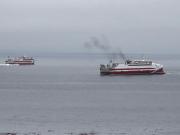
An 'old friend' returns to Gills Bay after an absence of manymonths. The 2,400 tonne 70 m.
Normand Cutter, The Norwegian-owned Offshore Construction Vessel at Gills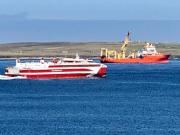
Here is the Normand Cutter, the Norwegian-owned offshore construction vessel that has been the base for works on Simec Atlantis Energy's (SAE's) MeyGen site in the Pentland Firth's Inner Sound, off Gills Bay during the current neap-tide sequence, that has lasted most of the week commencing 11.08.20. Picture by retired C of S Kirk Minister the Rev Lyall Rennie, who lives at Lower Warse, Canisbay, on the shores of Gills Bay..
New Ferry For Pentland Ferries Arrives Safely
Scotland's most modern + environmentally-friendly, fuel-efficient ROPAX ferry ship rge MV Alfred, arrived AM today (Wed 09.10.19 at St Margarets Hope. The boat went round to Kirkwall immediately at the end of 9,000+ miles voyage from the Strategic Marine yard near Ho Chi Minh city (ex.
Gills Harbour Ltd Awards Contract To Local Firm
Gills Harbour Ltd, the community-owned body that owns & operates the busy little port on Caithness's North Coast, has awarded a remedial contract to a Wick-based company. The deal, won in a competitive tender, has gone to builders/civil engineers Messrs GMR Henderson Ltd, of Martha Terrace in Wick.
